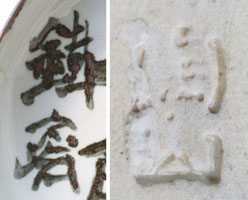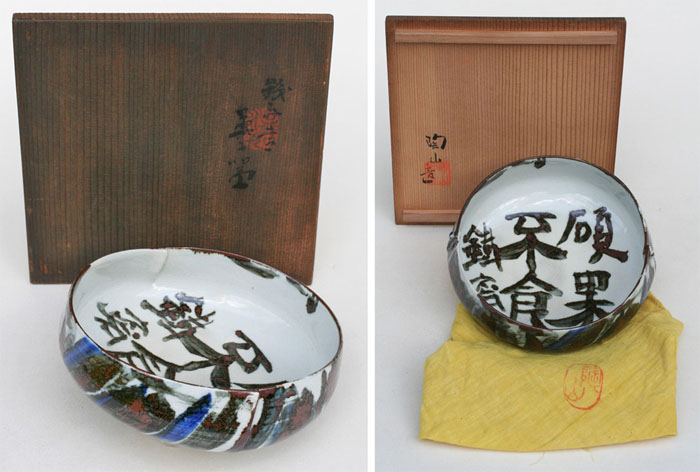Tea /Kyôyaki
Chawan, Sekka fujiki, lit. Big fruit remains uneatenSigned: Tessai
Seals: Tôzan
Technique: light grey crackled glaze with brown and blue iron oxyde under glaze inscription and decoration Ø 16 (14,5) x 6,2
Box: signed by Tôzan
Condition: fine
The inscription reads: 碩果不食 Big fruit remains uneaten. Part of a quote from the I Ching, the book of changes. (Which means something like: a large state does not perish.)
The complete quote: 碩果不食,君子得舆,小人剥廬。
A large state does not become rotten, a noble man sits in a carriage, the "common man" is deprived of his straw hut (= lacks support) i.e. the noble man is useful for the state, the common people does not really count.
Tôzan Iwas a leading figure in Kyoto pottery. He studied Maruyama-style painting with Koizumi Tôgaku. His wife was a potter and taught him pottery. He became an independent potter in 1863 and started his own kiln in 1867. In Uji he revived Asahi-yaki.
Reference:
Roberts p. 59
Tessai was born in Kyoto into a family selling robes and accessories for the Buddhist clergy. As a result of a childhood illness he became partly deaf. It was therefore considered improbable that he would ever become a successful shopkeeper. Instead he went to study the Japanese classics in order to become a Shinto priest. He also did Chinese studies, specializing in the teachings of the neo-confucianist Wang Yang-Ming. Later he would study Buddhism, literature and Shingaku, a semi-religious system for self-cultivation. As a youth he met Ōtagaki Rengetsu and became her special protégé. She taught him waka and encouraged his artistic inclinations. In the final years of the Tokugawa era Tessai was involved in the pro-imperialist movement. For fear of being arrested he left Kyoto in 1861 and travelled to Nagasaki. It was the first of many trips; Tessai became and avid traveller. In 1882 he settled in Kyoto where he spent the rest of his life. Although he worked as a priest at several Shinto shrines, he saw painting as his chief occupation. Between 1894 and 1904 he was a teacher at the Kyoto Prefectural Art School founded by Tanomura Chokunyū. He was a regular contributor to exhibitions of Chokunyū’s Nanga Society. In 1917 he was appointed Artist to the Imperial Household and towards the end of his life he received an honorary court-rank. Tessai is often seen as the last great exponent of the Nanga School.
Reference:
Kanazawa
Aichi arts Center 1996
Kato 1998
Morioka & Berry ‘99 pp. 116-121 (# 20-21)
Morioka & Berry ‘08 p. 305-06
Price: ON REQUEST

